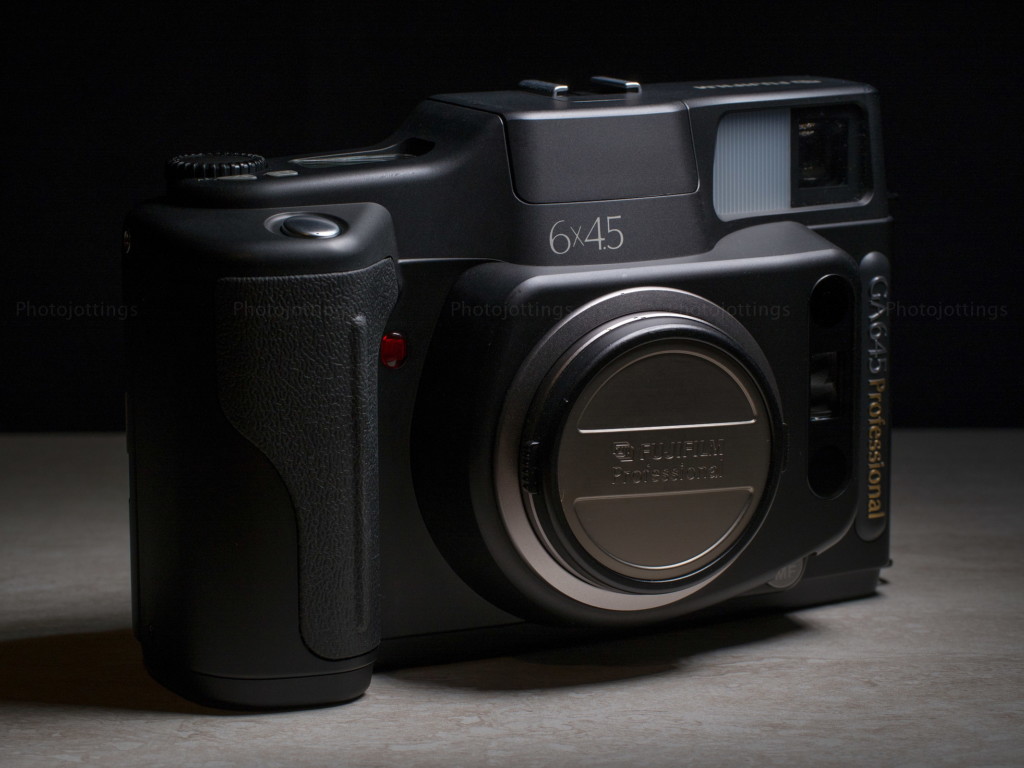
The Fuji GA645 ‘Professional’ is the companion model to the ‘wide’ version I reviewed here. Both are nearly identical, except for the lenses, so this review will look very much like the other one, with the lens differences pointed out when necessary.
The Fuji GA645 was a very modern and expensive camera for the professional photographer or rich amateur back in the mid to late 1990s. This particular model has a slightly wide angle lens of 60mm, and covers about the same as a 37mm in 135 format; the ‘wide’ Professional version has a 45mm F/4 lens which I reviewed here. The Fuji GA645 is a medium format camera that is feature rich, including full manual operation, and fully automated controls for quick point and shoot snap shots.
People looking to step up to medium format from an automated 35mm camera like the Nikon 35Ti will love the simplicities of the Fuji GA645 models, they both function basically the same, of course size being another matter. So you don’t know how to meter light, no problem, the camera does that for you. And you don’t know how to focus rangefinder cameras, no problem, its auto focus system is very accurate, and there’s no rangefinder to fiddle with. Do you like to write down your exposure settings for future use; well, you can keep your pencil in your pocket, the camera records the date and exposure settings along the film margins, not in the picture area!
With the introduction out of the way, let’s do a walk around of the Fuji GA645, and see what kind of performance this expensive mid 1990s medium format camera can deliver today!
Name; Fuji GA645 Professional.
Manufactured by; Fuji Photo Film Co., LTD., Tokyo, Japan.
Made in; Japan.
Date of manufacture; Approximately 1995-97.
Price; around $1300 US in the late 1990s according to photo magazine ad from a NY city discount dealer. ebay prices start around $500 for a good working model, and go up past $800 if it comes with a low shutter count, box and all the original contents.
Build material; appears to be a mixture of metal and plastic. Fit and finish are very good.
Box contents; camera, instruction manual, a softcase, neck strap, hood and cap.
Weight; my measurements ready to shoot; camera with hood and batteries, 28.4oz (805g).
Dimensions; my measurements; 6.5″ (169mm), 4.3″ (110mm) tall, and 2.6″ (69mm) deep. All dimensions include protrusions.
Focal length; 60mm. 60° diagonal angle of view.
Aperture; F/4-F/22 auto or manually set in half stop increments.
ISO; 25-1600 manually set in 1/3 stop increments.
Focusing distance; 27″ to infinity, or 0.7m to infinity. Auto focus sets the shooting distances in 870 steps, but uses 14 steps in the viewfinder.
Viewfinder; ‘portrait’ orientation illuminating window type bright frame finder with automatic parallax correction. Manual states 93% coverage at infinity, 91% at 1 meter, with a magnification of 0.5x.
Light meter; TTF, through the finder center weighted light metering SPD photocell.
Approximate resolution; good film and technique will make very sharp 16×20″ prints. See sample images farther down the page.
Distortion; none of my images show any discernible distortion.
Light fall-off; I see moderate “corner shading” when shooting at F/4; at other apertures I don’t see any.
Color fringing; none that I notice.
Back ground blur or “bokeh;” looks good when close to the subject at wide apertures, see picture below.
Lens; Fujinon Super-EBC (electron beam coating) 60mm F/4 multi-coated, 7 elements in 6 groups. Uses 52mm filters, B&H, Amazon, eBay.
Shutter and speed; super quiet electronic auto exposure inter-lens shutter with buzzer so you know when it trips! Speeds from 2 seconds up to 1/400 from F/4-9.5, and 1/700 from F/11-22, plus bulb mode.
Film; standard 120 or 220 roll, with a picture area of 56mm x 41.5mm. The “6×4.5” picture area is 2.7x larger than 135 film.
Flash; built-in pop-up type, guide number of 12 at ISO 100, not user adjustable in power. Fill flash only in aperture priority and manual modes.
Total shots indicator; push in the exposure compensation (+/-) button and hold, then turn the selecting dial from off to ‘ISO.’ It reads in increments of 100, and says it may have up to 200 test shots from the factory.
Power; two CR123a 3V lithium batteries, sometimes available at your local grocery/drug store, or these shops; B&H, Amazon, eBay. Fuji claims the batteries will last for 3000 shots with no flash use.
Accessories for this model; Fuji GA flash bracket, Fuji Strobe GA, and a Fuji GA Close up lens kit No. 5. I’m not sure if the close up lens kit is for use on the ‘Wide’ model, but I’m guessing it is since both cameras are the same outside, as well as close focusing distance.
Crippling features and omissions; nothing really bad, the only minor item would be TTF metering, and that means you have to manually compensate when using filters.
Good features; excellent lens, very accurate metering and focusing, auto parallax adjusting, self timer, auto first frame positioning, auto film advance, last shot beep, ±2.0 exposure compensation in half stop increments, and manual focusing via dial setting. I also like the pop-up flash, which is rare for a medium format camera.
Quirks; you only get 15 shots per roll, not 16 as some information suggests; only the newer “i” models get 16. Also, the camera works normally with the cap on, and you can see through the viewfinder, but you’ll get no pictures. The best way to avoid this is to leave the cap off, and put the hood on, that way you can’t attach the cap; at least on this model. The newest version GA645Zi has a lens cap warning beeper.
Problems; most of these cameras seem to suffer a bit from erratic “jumping” or “skipping” when using the up-down wheel. For example; when you want to go from F/9.5 to F/11, (which is one click), the settings may jump to F/22, or down to F4 etc. Apparently, according to several internet posts, some sort of factory lubricant used near the up-down dial has crept about, and is causing the problem. My camera has this problem too, but it really doesn’t bother me at this point. It sounds like it’s a fairly straight forward fix even for an amateur.
Other versions; there is a GA645W with a wide angle 45mm F/4 lens, but everything else is the same. There are also versions ending in “i” such as GA645Wi that have (among other things) two shutter buttons and a bar code film reader that automatically sets the film ISO. There is one with a 55-90mm zoom lens also reviewed here called the GA645Zi.
Go here to see the owners manual for the “i'” version, and make sure you tip the site owner.
Product shots with descriptions. Click pictures for larger versions.
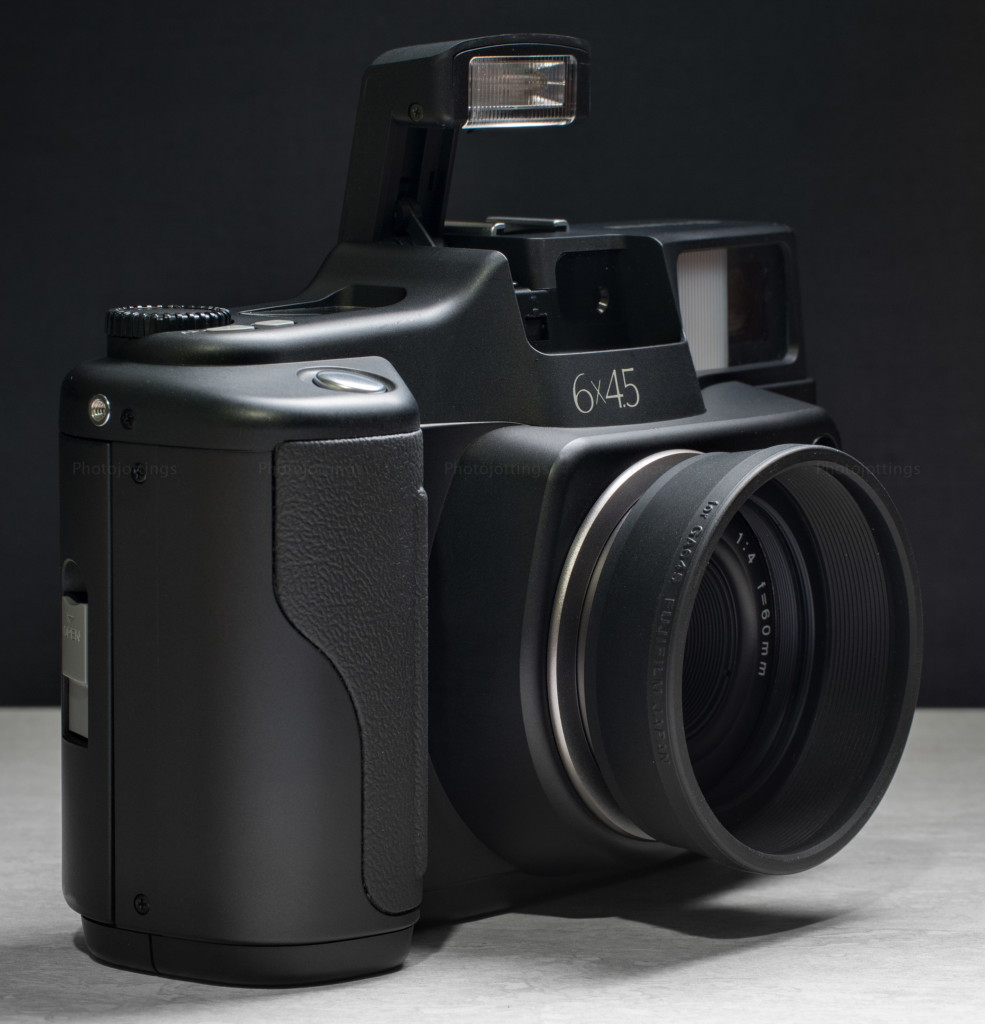
The Fuji GA645 ready to go; the screw-on rubber hood doesn’t cause any blockage of the flash.
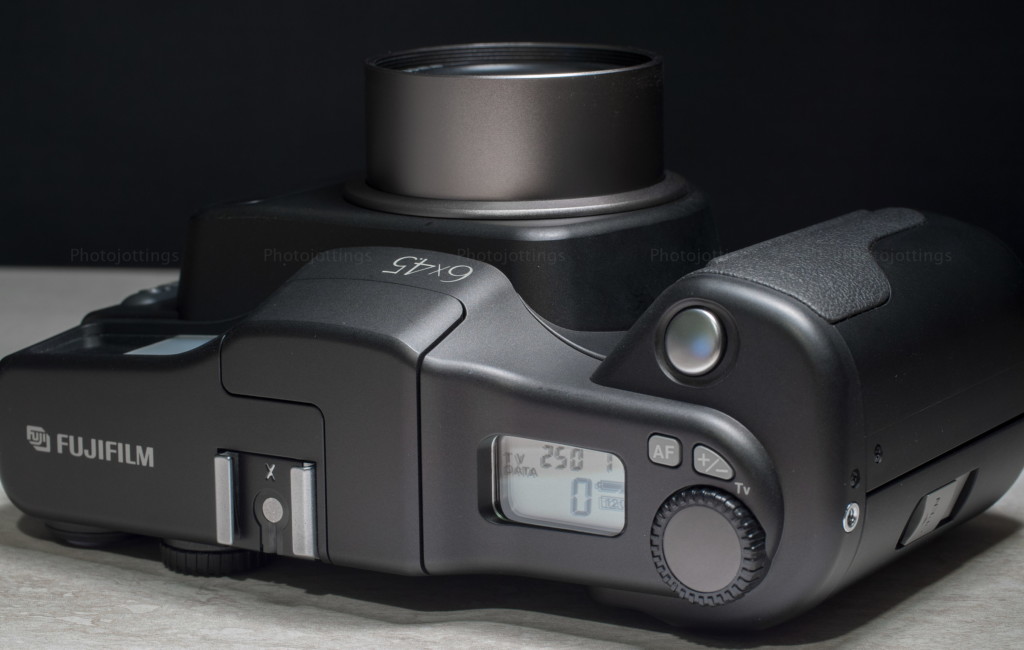
On top we have a hot-shoe in the middle, and LCD panel on the right showing ISO, shutter speed, film type, shot number, aperture, focusing distance, AF or MF, flash ready, battery indicator, and other data. The large up-down dial wheel is for adjusting settings like aperture, ISO shutter speed etc, oddly, it goes down when turned clock wise, that seems counter-intuitive. The +- button is for exposure compensation, and holding it down while turning the dial adjusts the shutter speed in manual mode. The AF button is for setting either auto focus or manual focus; and last but not least, the large silver button at the top of the grip is for tripping the shutter.

On the left we have the battery cover that holds two CR123a lithium batteries, with access by coin slot screw . The ¼-20 tripod socket is centered on the lens. The small little button to the right bottom is for mid-roll rewind. The two black circles are film loading knobs that you release via a red button inside the camera. Just visible is the gray colored MF button located under the lens. Press and hold while turning the up-down dial sets the focus manually.

The back of the camera is relatively uncluttered; the big square in the middle is a film reminder slot, the film box end fits nicely in here. The viewfinder in on the top left. You can use Nikon “F” style eye-pieces like these Nikon FM, FE, FA on this camera, and they’re interchangeable with the larger Fuji GW series. Go here for the review of the 6×9 big brother of this camera. The next dial is for selecting either ISO, Program mode, aperture priority, and full manual operation. The left gray button is for setting data such as date and imprinting on the film edges. The middle button is for the self timer. The black button is for popping up the flash.

The gray lever type catch on the right side opens the rear cover. On the inside of the back cover we have the film pressure plate, which can be adjusted from 120 to 220, and after doing so, it will show up on the LCD. The two red buttons are for popping out the film loading knobs so you can load your film, then press the knobs up until they lock. While loading the film you can jog the take-up spool for easier flap insertion into the spool slot by turning the up-down dial; the power doesn’t have to be on for it to work.
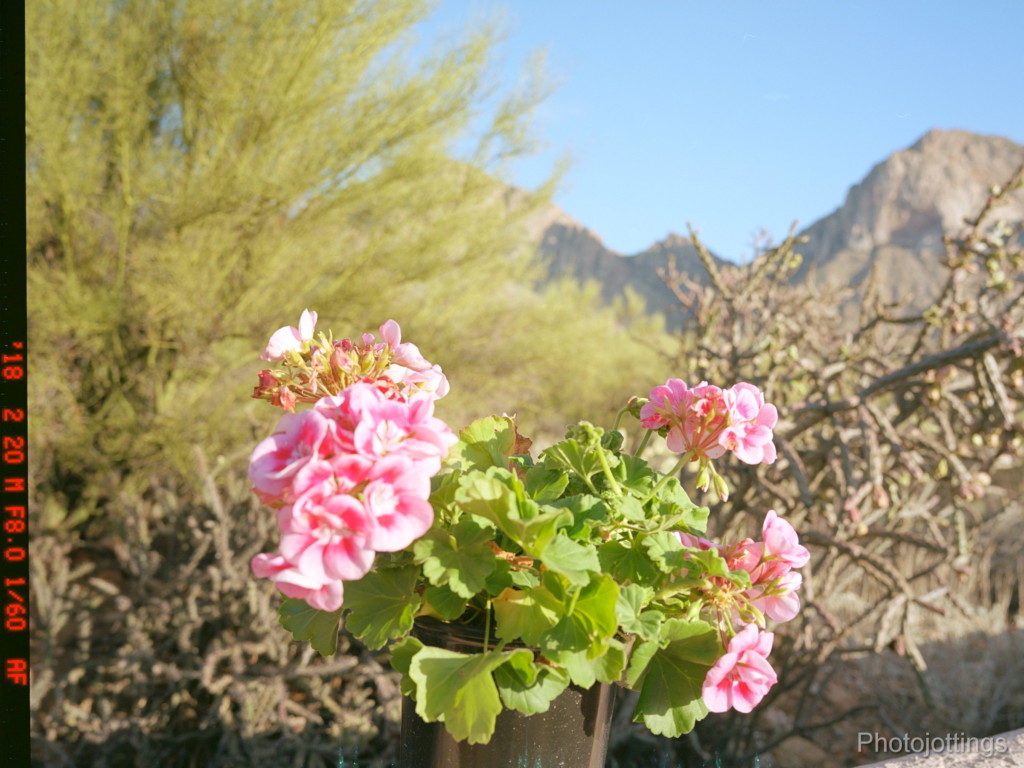
Note: here I used the same image from the 45mm F/4 wide angle review camera. This is the information you get on the margin of the film if you scan outside the picture area; I’m only showing one edge here, and you don’t normally scan beyond the picture area, especially if you’re using masks for flat scanning. I set the data to show the date and camera settings, but there are other settings to choose from. Reading from left to right, (or top down here), the date reads 18-2-20, or the 20th of February 2018. ‘M’ is manual mode, ‘F8.0’ is the aperture, ‘1/60’ is the shutter speed, and ‘AF’ is autofocus.
The data info is red for a positive image, but it will be bluish green when viewed as a negative. Also, the information is easy to read here, however, when you’re actually looking at the negative, it’s really small, and you’ll need a magnifying glass to read it.
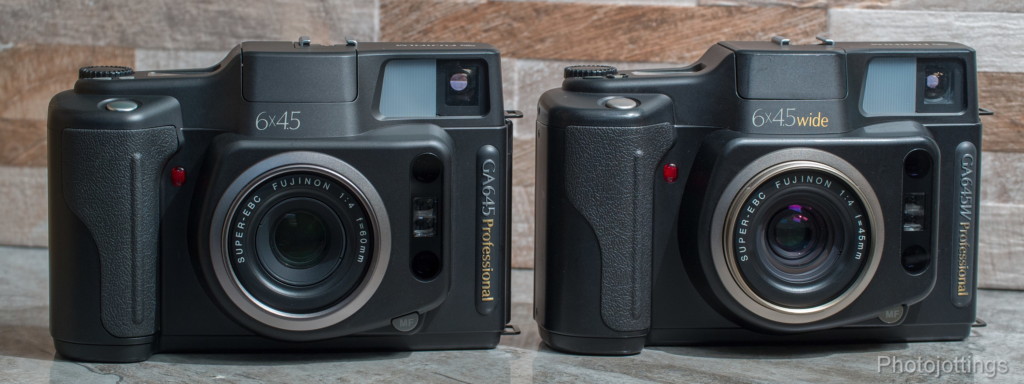
Both prime lens models of the GA645 series.
Sample shots below.
Here are a few samples for your viewing pleasure. They’re about 5500 pixels wide. Click images for a larger version.

Cholla Cactus, F/4. Distance is the same as a torso shot of people. Background blur is harsh in the corners. Kodak Ektar 100.

Geraniums at F/4, close focus. Central bokeh looks pretty smooth, but gets busy towards the corners. Kodak Ektar 100.
For the test shots below I used Fuji Provia 400x, which is a high-speed Color reversal, (slide) film that has some good qualities, but also has a bit less resolution and more grain than Fuji’s other color reversal film. With that said, I really like the film, and use it in the late afternoon quite often with medium format cameras. Unfortunately, this film has recently been discontinued; and good luck finding fresh film at any reasonable price. All pictures below were scanned and saved at 5500 pixels wide.

Leo’s Drugs, F/4. Depth of field is pretty substantial with this lens given a little distance. Fuji Provia 400X.
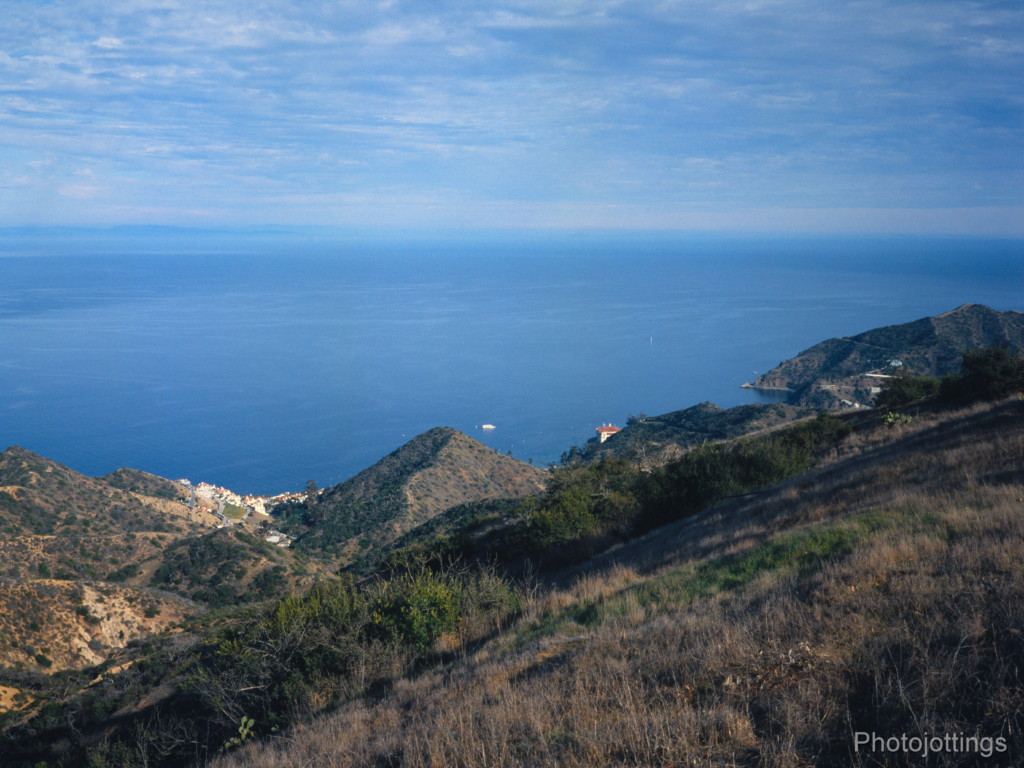
Harbour town, F/13. Fuji Provia 400X.

Late sun, F/11. Fuji Provia 400X.

Crescent Ave walk, F/11, Fuji Provia 400X.
Test scene below.
All test shots are displayed at 5500 x 4125 pixels wide when enlarged, and that’s all the resolution included in the film. Scanned on a Nikon Coolscan 9000 ED.
Here is our standard Mountain test scene, this time using Kodak Ektar 100 film. A tripod was used, but no filters. Click to enlarge.

F/4. Quite sharp with plenty of contrast here, even along the sides.

F/5.6, about the same as F/4.
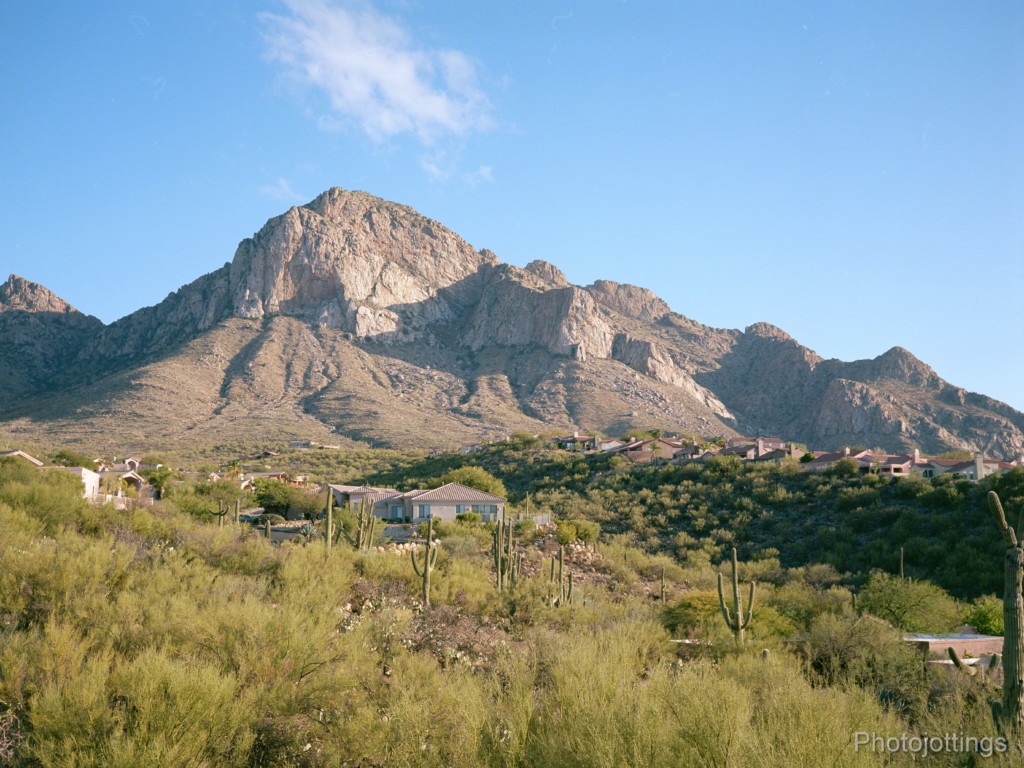
F/8. Nice jump in resolution and contrast at this aperture.

F/11. The extreme sides are as sharp as the centers; I see no diffraction softening yet.

F/16. Here the image softens very slightly due to diffraction.
Conclusion.
The Fuji GA645 turned in a great review, just like the ‘wide’ model I reviewed, they’re almost the same camera, so I was not surprised at the outcome.
There are a lot of positives to mention for this wide angle camera: the lens is very sharp with plenty of contrast, even when used wide open; the exposure metering system is excellent, which is a must for color reversal or “slide” film, and the focusing is dead-on in good light. Having a pop-up flash on a medium format camera is a rarity, and I actually use it quite often for fill when photographing people. I generally don’t use program mode, but it works just fine if you’re a point and shoot person. Another real plus is the date and exposure imprinting on the negative margin, that saves me from having to stop and write down my exposure settings after each shot.
I don’t see any real downers for this camera, but just for fun let me mention a few items that could’ve been implemented or improved in the updated model. Low light focusing is not always spot on, but only noticeable at wide apertures. It takes two sometimes pricey batteries that may not be available at your vacation destination, so keep a spare set handy. Filter use requires compensation (really easy to do though) as the metering is through the finder. Also, don’t forget the camera will work just fine with the lens cap on, so don’t forget to take it off at the start of your picture taking session, otherwise, no pictures for you!!
I like the Fuji GA645, it provides substantially more resolution than 135 format cameras, which will show up when making large prints, or looking at your images on a 5k screen. The actual picture size on the film is also much larger than 135 format, (2.7x the area), which makes direct viewing of color transparencies more enjoyable.
I’m just thinking out loud now, but I wish Fuji would’ve made the wide model even wider, like maybe 38mm, which would make it similar to a 24mm in 135 format. The differences between 45mm and 60mm is not really all that much when photographing landscapes; but for interior work there’s a big difference.
Anyhow, when it’s all said and done, theFuji GA645 is a precision tool for the discriminating photographer, and ironically, equally suited for the novice because of the well implemented fully automated features.
Please consider buying through my links and help support the site. Thanks for visiting!